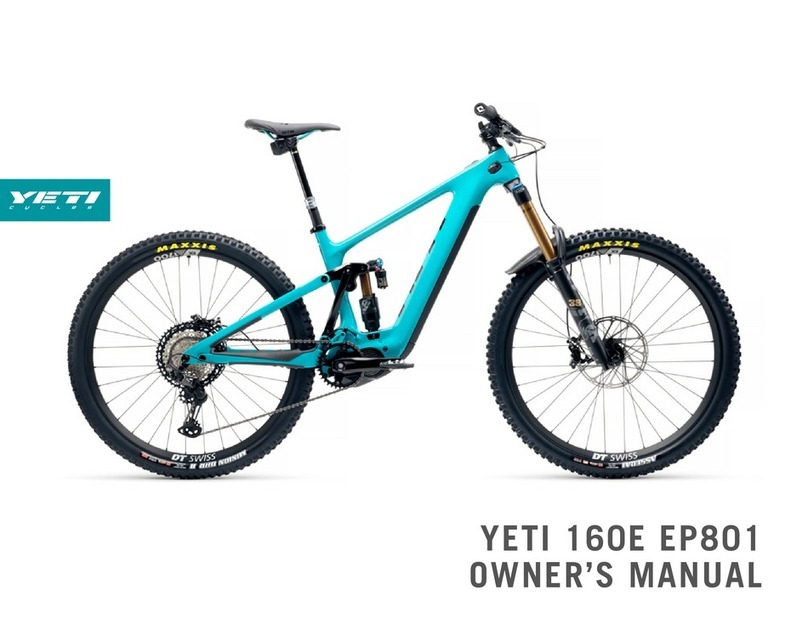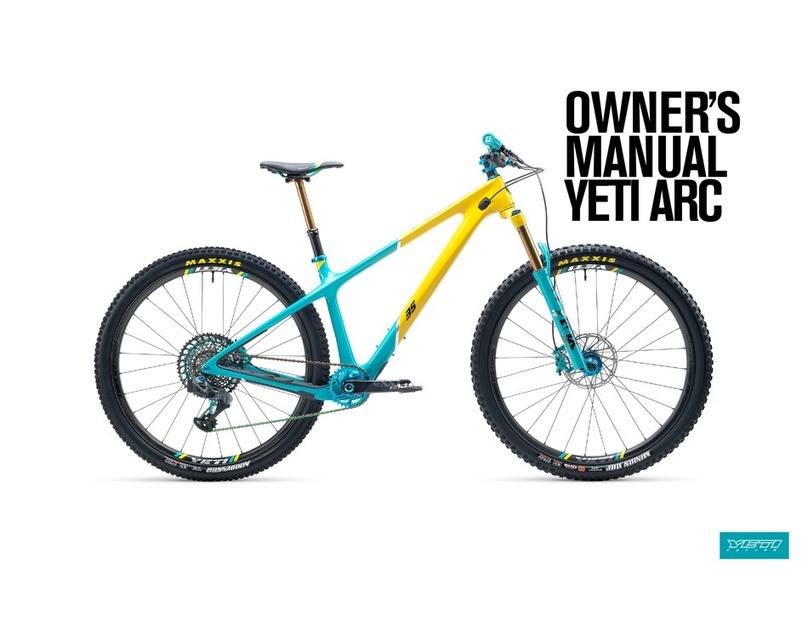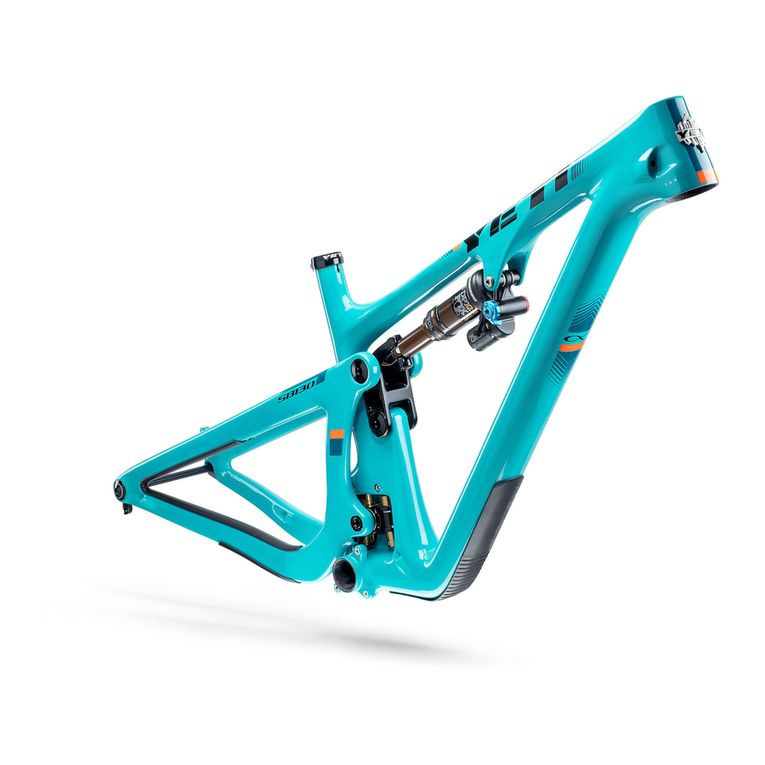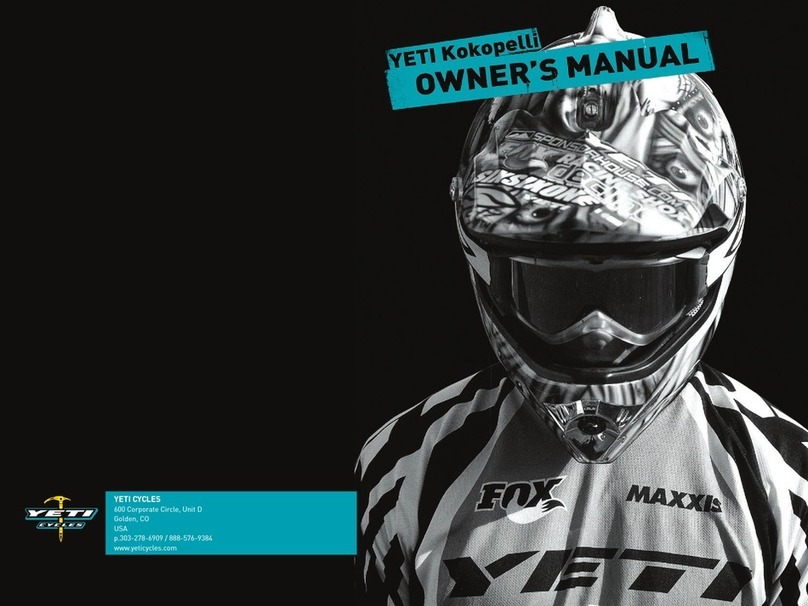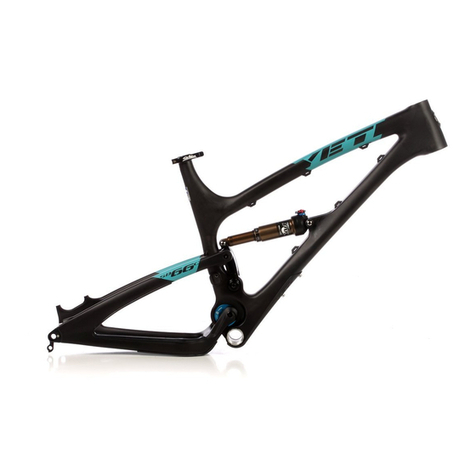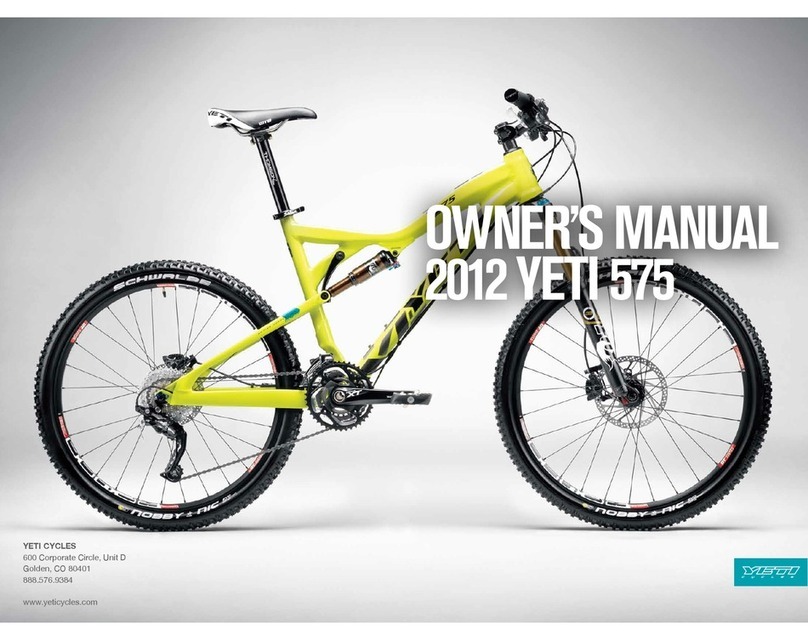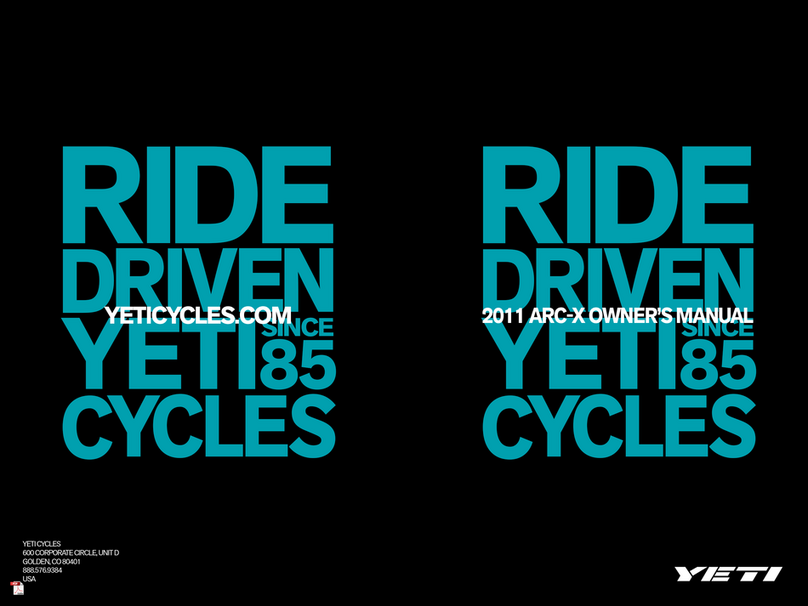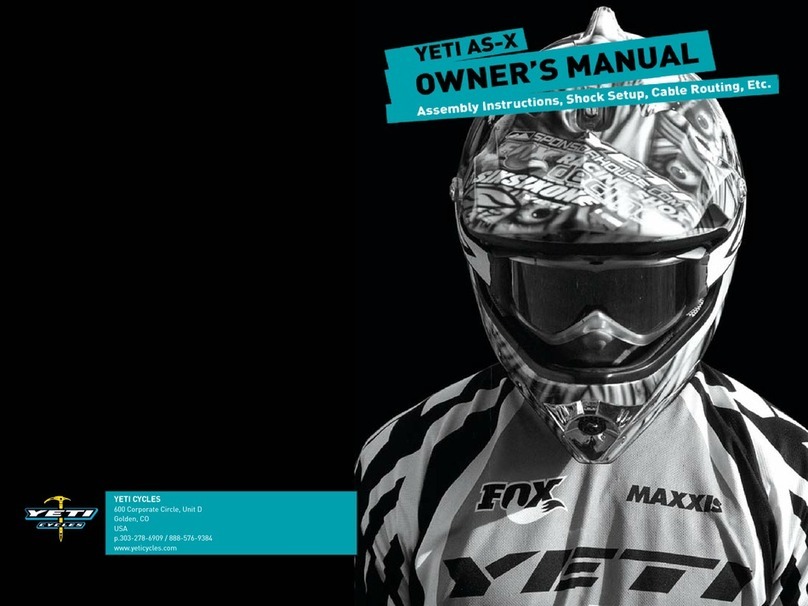Yeti 575 '08-'09 User manual

575 OWNERS MANUAL ‘08-’09
YETI CYCLES
600 Corporate Circle, Unit D
Golden, CO
USA
P//303.278.6909 // 888.576.9384
www.yeticycles.com

Table of Contents
Brand Overview 6
Frame Features 8
Geometry 10
Maintenance Schedule 12
Bike Setup Overview 14
ūShock Setup FOX RP23 16
ūShock Setup FOX DHX Air 17
ūQuick Start Guide 19
ūCable Routing 20
Assembly Overview 22
ūAssembly 24
ūDisassembly Tips 27
Exploded Views 28
Part List 30
Warranty 32

6
OVERVIEW
Overview
WELCOME TO THE TRIBE
Congratulations on your purchase of a new
Yeti bicycle and welcome to the Yeti Tribe. We
are confident your new bicycle will exceed your
expectations for value, performance and ride quality.
Each frameset and component has been custom
specified and designed to enhance your riding
experience. Whether you are a beginner cyclist or
a seasoned-pro, Yeti bicycles will provide endless
hours of two-wheeled fun.
GENERAL INFORMATION
This model-specific manual is designed to be
used in conjunction with the general Yeti Owner’s
Manual and the manuals supplied by the suspension
manufacturers. If you did not receive the Yeti
Owner’s Manual or the manual provided by the
suspension manufacturer, download the materials
off the Internet, or contact you dealer.
Bicycling can be a hazardous activity
even under the best of circumstances. Proper
maintenance of your bicycle is your responsibility and
when done properly helps reduce the risk of injury
and damage to your bicycle. This manual outlines
basic setup and maintenance recommendations of
your new Yeti. Because it is impossible to anticipate
every situation or condition that may occur during
the assembly, setup and maintenance of your bicycle,
Yeti recommends that all service and repairs be
Warning: Make sure you review and understand the warnings, instructions and content of this manual and
accompanying manuals for your bicycle.
Warning: Technological advances have made bicycles and bicycle components more complex and the pace of
innovation is increasing. It is impossible for this manual or accompanying manuals to provide all the information
required to properly repair and maintain your bicycle. In order to help minimize the changes of injury, it is critical for you
to have work performed by an authorized Yeti dealer.
performed by an authorized Yeti dealer.
This manual contains many “Warnings”
and “Cautions” concerning the consequences of
failure to maintain or inspect your bicycle. The
combination of the safety alert symbol and the word
“Warning” indicates a potentially hazardous situation
in which, if not avoided, could result in serious injury
or death. The combination of the safety alert symbol
and the word “Caution” indicates a potentially
hazardous situation in which, if not avoided, may
result in minor injuries or damage to your bicycle
or a component of your bicycle. Be sure to read and
understand all “Warnings” and “Cautions”.

8
Frame Features
FEATURES
1. PURE TUBING
Yeti pure tubing is custom butted and tapered 7005 aluminum.
This makes the frame lightweight and strong without the use of
gussets. Unique shape provides added strength at the head tube
junctions.
2. BOTTOM BRACKET
73mm shell, for use with a 113mm spindle.
3. CARBON REAR TRIANGLE
Full carbon rear triangle with a bridge between the seatstays. It
provides a noticeable increase in rear wheel stiffness.
4. FLEX PIVOTS
CarbonFlex pivots allowed us to shave weight and increases
performance. I-Beam construction has great lateral stiffness
and enhances suspension performance.
5. SHOCK
7.875” eye-to-eye / 2” stroke.
6. DOGBONE
Dogbone controls suspension rate and enhances rear end
stiffness. Sealed bearings allow the dogbone to move freely.
7. HYDRFORMED TOP TUBE
The hydroformed tube produces a stronger, lighter, and more
rigid tube for increased stiffness while reducing weight. It also
allows for greater stand-over clearance.
8. MAIN PIVOT
Oversized sealed bearings on main pivot for low maintenance and
stiction-free performance.
1
7
4
5
2
3
8
6

10
Geometry
GEOMETRY
GEOMETRY 575
140 MM FORK (RIDE HEIGHT 511MM)
XS S M L XL
A15.8 17.5 18.5 20.5 21.5
B21.8 22.8 23.8 24.8 25.6
C68.5 68.5 68.5 68.5 68.5
D72 72 72 72 72
E16.9 16.9 16.9 16.9 16.9
F42 43 44 45 45.9
G13.25 13.25 13.25 13.25 13.25
H28.5 29 29 29 29
I3.6 4.5 4.5 5.25 6
160 MM FORK (RIDE HEIGHT 545MM)
XS S M L XL
A15.8 17.5 18.5 20.5 21.5
B22 23 24 25 25.8
C66.9 66.9 66.9 66.9 66.9
D70.4 70.4 70.4 70.4 70.4
E16.9 16.9 16.9 16.9 16.9
F42.5 43.5 44.5 45.5 46.4
G14 14 14 14 14
H29.5 29.7 29.7 29.7 29.7
I3.6 4.5 4.5 5.25 6
*All measurements are in inches.
C
D
A
B
I
E
F
H
G

12
Maintenance
MAINTENANCE
MAINTENANCE Following these guidelines will help maintain the performance of your bicycle and prevent
more serious problems from arising. It is important to remember that service intervals can vary depending
on climate, trail conditions and riding frequency.
Caution: The torque specications listed should be used as a guide when performing maintenance. Technological
advances have made bicycles and bicycle components more complex, and the pace of innovation is increasing.
Because of these advances, Yeti recommends that you refer to the torque specications of the manufacture’s component
you are adjusting. In order to help minimize the chances of injury, do not perform any maintenance that you are no
condent can be completed within your abilities.
MAINTENANCE? Not sure how to work on your own bike?
Contact your authorized Yeti dealer or visit www.parktool.com
and check out the repair help section. This section contains
detailed instruction on many of the service items listed in the
maintenance schedule.
TORQUE We have attached a brief list of torque specifications for bolts and components that may need to
be tightened while performing basic maintenance. This is just a guide. For specific torque, specifications,
please contact the component manufacturer directly.
TORQUE SPECS
Pivot Bolts 125 -150
Derailleur Hanger Bolts 30 -45
Handlebar Binder Bolt 150 -180
Stem Binder Bolt 175 -260
Seatpost Binder Bolt 150 -180
Saddle Clamp Bolts 175 -250
Rear Derailleur 70 -86
Front Derailleur Clamp 45 - 60
Chainring Bolts 88 -132
ACTION WEEKLY MONTHLY 3 MONTHS ANNUALLY
Clean and lube chain x
Check tire pressure x
Clean bike of mud and debris (never
spray water directly into frame or
components)
x
Check brake function x
Check shock pressure, if applicable x
Check for loose bolts and tighten, if
necessary
x
Check headset and tighten / loosen, if
necessary
x
Thoroughly clean pivot points with a
rag (do not lubricate)
x
Replace brake pads, if necessary x
Check tires for wear x
Check spoke tension and retention, if
necessary
x
Check chain for worn, damaged, or
loose links, replace chain if necessary
x
Complete tune-up performed by an
authorized Yeti dealer
x

14
Bike Setup
SETUP
TOOLS NEEDED
Shock pump
Tape measure
4mm allen key
TIME
15-20 minutes
YETI TIPS
Inspect your shock for any visible damage. If
oil is leaking or you notice any damage to the
surfaces or seals, please contact the Fox Racing
Shox service center for repair at 800.FOX.SHOX.
Removing the shock from the linkage will
require the Yeti linkage tool for proper assembly
and disassembly. The tool can be purchased
online at www.yeticycles.com or through an
authorized Yeti dealer.

16
Setup-Fox RP23
SETUP SHOCK RP23
Setup-Fox DHX Air
PRO-PEDAL The pro-pedal dampening has two settings and three
levels of adjustment and is controlled by the blue lever (formerly
the lock-out lever). The two settings are open and propedal. Use each
setting to adjust the shock for different riding conditions and situations. For
example use propedal for riding to the top of the mountain and then switch
to open for the descent.
The pro pedal knob has three different levels of dampening: (1) light, (2)
medium and (3) heavy pro-pedal. If the bike feels too firm, put it on a light
setting, and if it feels too sluggish, turn it to the stiffer setting.
AIR PRESSURE The main air spring controls the sag of the shock.
For the 575 to ride properly it is important to setup the shock with the
correct amount of sag. For general riding use 20-30% of the shock stroke
(5mm to 10mm). To increase sag reduce the main spring air pressure. To
reduce sag increase the main spring air pressure. Refer to the quick start
guide to get your starting air pressure.
SAG Once you have set your baseline air pressure you need to
measure the sag. To measure the sag slide the travel indicator
(O-Ring) up against the shock body. With a friend supporting the bike, sit
on the saddle (do not bounce) and allow your body weight to compress
the shock. Once you have compressed the shock, get off the bike and
measure the distance between the shock body and the new position of the
travel indicator (O-Ring). This is your sag. Refer to the guide below for the
percentage of sag equivalents for the measurement recorded.
Firm ride- 20-25% sag // Plush ride- 30% sag
REBOUND The rebound adjustment has 8-10 clicks of adjustment.
The rebound knob is the red adjustment dial located above your blue
pro-pedal adjustment lever. As a general rule, adjustments that are too fast
(counter-clockwise adjustment) will produce a springy ride with excessive
kick-up of the rear end causing a bucking sensation. Adjustments that
are too slow (clockwise adjustment) will cause packing of the rear wheel
indicated by a sluggish ride feeling ride.
Slower rebound- turn the knob clockwise
Faster rebound- turn the knob counter-clockwise
4
SETUP OVERVIEW The DHX 5.0 employs both speed sensitive rebound damping and positive sensitive
compression damping. There are three external adjustments that affect the compression and one external
adjustment for the rebound. The three compression adjustments are bottom-out resistance, boost valve and
pro-pedal. The pro-pedal controls the anti-bob properties of the shock or the first part of the shock’s stroke;
the bottom-out resistance controls the end of the shock stroke; and the boost valve damping links these
two adjustments together to create a seamless transition through the entire stroke. The boost valve also
decouples the pro-pedal and bottom-out resistance making these adjustments independent of each other.
AIR PRESSURE The main air spring controls the sag of the shock.
For the 575 to ride properly it is important to setup the shock with
the correct amount of sag. For general riding use 20-30% of the shock
stroke. To increase sag reduce the main spring air pressure. To reduce sag
increase the main spring air pressure. Refer to the quick start guide to get
your starting air pressure.
Firm Ride - 20-25% sag
Plush ride - 30% sag
1
Warning: Use of the shock with improper air pressure can cause loss of
dampening and malfunction of the shock.
BOOST VALVE The DHX 5.0 has an air pressure range of 125-200 psi,
and it must be pressurized for the shock to work properly. The Boost
Valve allows the Pro-Pedal (beginning compression) and the Bottom-Out
Resistance (ending compression) to work seamlessly together. Because
of this relationship the Boost Valve pressure affects both the Bottom-Out
Resistance and the Pro-Pedal Adjustments (see adjustment relation).
Lower pressures (125 – 150 psi)- Will decrease bottoming resistance and
lessen pro-pedal stiffness at a given setting.
Higher pressures (160 – 200 psi)- Will increase bottoming resistance and
stiffen pro-pedal at a given setting.
Warning: Use of the shock with improper air pressure can cause a loss
of dampening and shock malfunction could occur. Do not attempt to turn the
adjuster with more than 125 psi in the chamber.
2
1
2
3

18
Setup-Fox DHX Air
SETUP DHX AIR
Quick Start Guide
WHAT IS PRO-PEDAL? Pro-pedal is a compression tune that
gives the right amount of low-speed compression to filter out
unwanted rider-induced bob without sacrificing critical mid-
and high-speed damping. No flushing through your travel,
no wasted setup time, and no energy-sucking suspension
movement. Just super efficient pedaling performance ready
for hits of any size.
SAG Once you have set your baseline air pressure you need to
measure the sag. To measure the sag slide the travel indicator
(O-Ring) up against the shock body. With a friend supporting the bike, sit
on the saddle (do not bounce) and allow your body weight to compress
the shock. Once you have compressed the shock, get off the bike and
measure the distance between the shock body and the new position of the
travel indicator (O-Ring). This is your sag. Refer to the guide below for the
percentage of sag equivalents for the measurement recorded.
3
REBOUND The rebound adjustment has a 22 click range. As a general
rule, adjustments that are too fast (counter-clockwise) will produce a
springy ride with excessive kick-up of the rear end. Adjustments that are
too slow (clockwise) will cause packing of the rear wheel and give the bike
a sluggish feel.
Slower rebound - turn the knob clockwise
Faster rebound- turn the knob counter-clockwise
BOTTOM-OUT RESISTANCE The bottom-out adjuster has three
full turns of adjustment. This adjustment controls the bottom out
resistance of the shock, or the compression on the final part of the shock’s
stroke. If you feel like you are bottoming-out the shock on big hits, you can
minimize this sensation by increasing the bottom-out resistance.
More resistance- clockwise rotation
Less resistance- counter-clockwise rotation
The adjuster can be turned by hand or with a 4mm allen key. The allen key
should be placed into one of the holes on the perimeter of the adjuster.
PRO-PEDAL The pro-pedal adjustment has a min/max adjustment.
The pro-pedal damping affects the first half of stroke where most
rider induced bob occurs.
More Damping - clockwise rotation
Less Damping - counter-clockwise rotation
5
4
6
QUICK START GUIDE RP23 575
AIR SPRING SETTINGS
Rider Weight (lbs) 125 135 145 155 165 175 185 195 205 215
Air Pressure (psi) 135 145 155 165 175 185 195 205 215 225
*EXTERNAL ADJUSTMENTS
Rebound 5 Clicks
Pro-Pedal Lever On//Active
Pro-Pedal Knob Position 2
SAG SETTINGS
Sag % 20 25 30
Measured (mm) 10 12.5 15
QUICK START GUIDE DHX AIR 575
AIR SPRING SETTINGS
Rider Weight (lbs) 125 135 145 155 165 175 185 195 205 215
Air Pressure (psi) 145 155 165 175 185 195 205 215 225 235
Boost Valve Settings 109 116 124 131 139 146 154 161 169 176
*EXTERNAL ADJUSTMENTS
Rebound 10 Clicks
Bottom-Out Resistance 1.5 Turns
Pro-Pedal Lever Min. Settings
SAG SETTINGS
Sag % 20 25 30
Measured (mm) 10 12.5 .15
*All quick start setting adjustments are clockwise rotation from all the way out
or a full counter-clockwise position.

20
The 575 has full cable housing. By using full cable housing, we have eliminated break points in the line
of your shifter housing. This allows riders to experience better overall shifting performance by reducing
the entrance of unwanted elements such as sweat and sediment. Use of full cable housing helps prevent
corrosion from the elements and keeps the shifting smoother for a longer period of time.
Cable Setup
SETUP HOUSING
HOUSING END CAPS Yeti recommends using metal end caps
to maintain the integrity of the housing. The metal caps do not
allow the cable to pull through as do the plastic versions. Do
not mix up the shift and brake housing because it will result
in a loss in performance.
Caution: The failure to properly route shifter housing can cause malfunction of the shift mechanism and unexpected
shifting of gears.
REAR DERAILLEUR Fit the housing from the rear shifter across the
head tube and down the cable stops. There are three cable stop
groups on the non-drive side of down tube to which the housing and brake
line can be attached, each with two positions to secure housing. Fit the
rear housing line along the down tube through these stops, using the
position closest to the drive side.
Next route the housing over the bottom bracket and continue under the
drive side chainstay. Attach the housing to the two cable stops on the
bottom of the drive side chainstay using cable clips or zip ties, and loop the
housing into the rear derailleur to finish.
FRONT DERAILLEUR Fit a piece of housing from the front shifter
across the head tube and into the single cable stop on the drive side
on the down tube. The wire cable runs the length of the down tube and
into the cable guide on the bottom of the bottom bracket shell. The guide
should always be oriented so the longer part of the guide is closest to the
drive side of the frame. Run the wire cable through the guide and attach to
the derailleur to finish.
REAR BRAKE The rear brake line loops across the head tube and
runs onto the stops on the non drive side of the down tube. Use the
position closest to the non-drive side on the cable guides for the rear brake
line, and attach the line to guides using cable clips or zip ties.
Next route the brake line over the bottom bracket shell and across the non
drive chainstay. Secure the line to the single cable guide on the chainstay
with a cable clip or zip tie. Ensure the line is finished on the inside of the
seatstay when attached to the caliper body. This will prevent the brake line
from being compromised if the bike or rider falls.
1
2
3
This manual suits for next models
1
Table of contents
Other Yeti Bicycle manuals
